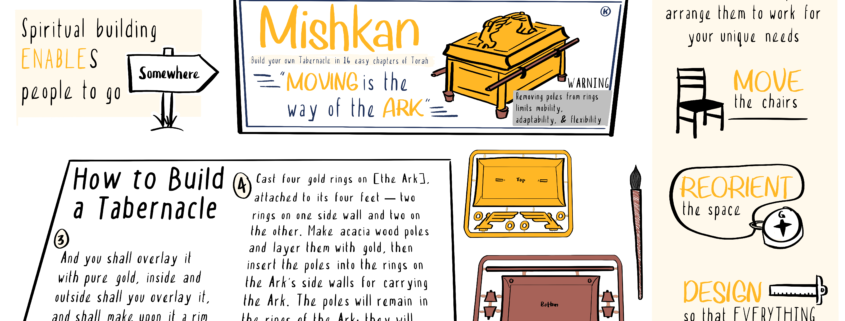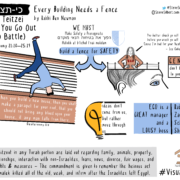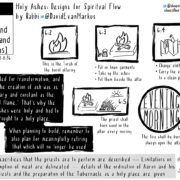Building for Mobility: Spiritual Life on the Move

Part of a yearlong series on Torah’s wisdom about building and builders in Jewish spiritual life.
So far, Builders Blog traced Torah’s first 18 portions, harvesting lessons about spiritual building from our spiritual ancestors’ lives and early journeys.
Now in the 19th portion (Terumah) comes Torah’s building story par excellence, about building the Mishkan – the holy structure to focus the sacred’s indwelling presence among the people. Finally, a building story that’s literally about building! Or is it?
 Torah first describes the Ark to hold the two tablets of Commandments, then the cherubim atop the Ark, then takes another 15 chapters to map out the Mishkan. These ordered priorities teach that the Mishkan isn’t for itself but for what’s inside.
Torah first describes the Ark to hold the two tablets of Commandments, then the cherubim atop the Ark, then takes another 15 chapters to map out the Mishkan. These ordered priorities teach that the Mishkan isn’t for itself but for what’s inside.
We learn that no spiritual structure legitimately can serve mainly itself: it’s all for what’s within. Any spiritual structure, building or system that serves mainly itself misses the point of building it.
Which begs the question: what’s the point of building?

One answer is the Commandments (or callings, or connections). Another is to remind of the One who spoke (and speaks) them from Sinai. I’m good with those answers as far as they go.
But to me, the point of building is going. Spiritual building is about going somewhere: the act of building or going inside a building is supposed to transport and transform us.
Hence the gold rings soldered onto the Ark. After describing the Ark but before describing the cherubim on top, Torah records these instructions (Exodus 25:12-15):
“Cast four gold rings on [the Ark], attached to its four feet – two rings on one side wall and two on the other. Make acacia wood poles and layer them with gold, then insert the poles into the rings on the Ark’s side walls for carrying the Ark. The poles will remain in the rings of the Ark: they will never be removed from it.”
Only after Torah set forth the Ark’s poles and rings did Torah have the Ark receive the tablets of the Commandments.

Why does Torah instruct never to remove the Ark’s poles from the rings? So the Ark always is ready to move on a moment’s notice, and so we can be ready to move with it. Moving is the way of the Ark. And why teach this truth before the Ark receives the tablets of the Commandments? So they also could move and not be stuck even for a moment.
We all tend to get stuck and sometimes justify it: we even say that “tradition” or “spirituality” require things to be how they are. But our ancestors turned that idea on its head. The medieval Da’at Z’kenim held that Moses himself attached the Ark’s rings and poles, and that removing them even for an instant would sever our link to Moses!
Moving is the way of the Ark, the way of Moses, and the way of all spiritual life. As R. Marcia Prager put it, even movements are called movements because they’re supposed to move.
That was then; how about now? How do we build for spiritual mobility today and tomorrow?

We start by recognizing the opposite of spiritual mobility, which is habituation, even numbness. Some spiritual habits encourage discipline and depth, while others grow numb and dull. The Ark’s poles and rings teach that we always must be ready and willing to move, to not get stuck.

We can start small. Move chairs, reorient space, swap out tunes – maybe not all at once and never just for the sake of change, but to start feeling movement. It takes time for communities habituated to certain ways to feel resilience, but that’s what the Ark’s poles and rings ask.

And don’t be content just moving the proverbial deck chairs. Design spiritual spaces to be open, flexible and adaptable. Make everything moveable. Even more, try going out from fixed spaces entirely: if the ancient Ark could move about nature, so can we. Build spiritual life with moments in the woods, in fields, at the shore, in homes and in public spaces. Communal spiritual spaces are important to community cohesion, but spiritual life is exactly about not being fixed in a place!
Just as Jewish places must move, so must Judaism. A Judaism that clings to preservation, that loses its ability to move and adapt on a moment’s notice, loses its link to Moses. Jewish life isn’t mainly about preservation but rather about change. When we forget that change is a core value of Jewish life, we risk losing our own links to what’s most important.

So build for spiritual mobility. Build to move. When we build a Jewish spiritual life that can move, it can move us. Motion, for emotion, is the Sanctuary in which the holy can dwell among us.


By Rabbi David Evan Markus. Sketchnotes by Steve Silbert.









Trackbacks & Pingbacks
[…] link. Apologies! Here’s the correct link for last week’s commentary from Bayit: Building for Mobility: Spiritual Life on the Move by R’ David […]
Comments are closed.